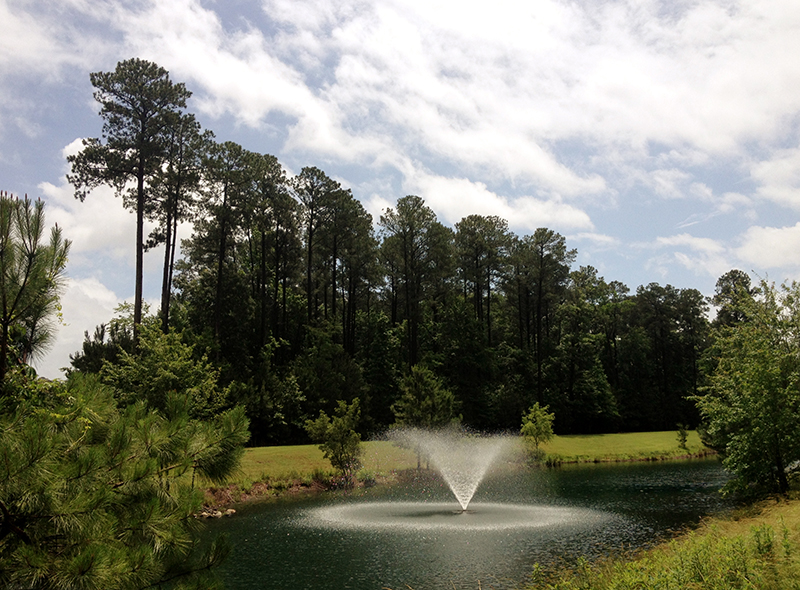Stormwater Management Trends: Eco-friendly Pond Maintenance
July 30th, 2018
AS SEEN IN Quorum, Washington Metropolitan Chapter and Community Associations Institute: Written by Industry Expert Shannon Junior, Aquatic Ecologist
 The last decade has brought major changes to the pond and lake management industry. Every community that has privately maintained ponds, lakes or stormwater best management practices has responsibilities to manage the structural, functional and aesthetic integrity of the facilities. The primary ongoing maintenance issue in these facilities is typically the prevention and control of nuisance aquatic vegetation.
The last decade has brought major changes to the pond and lake management industry. Every community that has privately maintained ponds, lakes or stormwater best management practices has responsibilities to manage the structural, functional and aesthetic integrity of the facilities. The primary ongoing maintenance issue in these facilities is typically the prevention and control of nuisance aquatic vegetation.
Historically, a baseline management plan for a stormwater management facility would include frequent and repetitive herbicide applications for the control of unwanted algae and weeds. However, in recent years the regulatory environment has become more constraining. The National Pollutant Discharge Elimination System permit for aquatic herbicide applications went into effect late in 2011 and requires that integrated pest management strategies are considered prior to the decision to apply herbicides for nuisance vegetation control. In addition, the public has become more wary of herbicides and residents have been requesting more environmentally friendly strategies for management.
The purpose of stormwater management facilities is not only to mitigate stormwater runoff, but also to retain sediment, nutrients and other pollutants to protect downstream water resources. As these substances accumulate in a pond over time, the water quality in the facilities becomes impaired and algae and nuisance vegetation growth become more prevalent and problematic.
Treating blooms of pond algae and weeds with an herbicide provides short-term symptomatic relief, but does not address the underlying issue of nutrient enrichment that is ultimately causing the problem. In order to provide more long-term, sustainable solutions, new management strategies involve an integrated approach that includes the implementation of multiple nonherbicide methods to improve water quality and reduce the conditions that cause nuisance vegetation blooms.
Identification of the specific species of algae that are present in a pond and the water quality parameters and sediment characteristics of the waterbody has become critical in the development of site-specific management strategies and we have been recommending these analyses to most of our clients.
Cyanobacteria, aka blue-green algae, blooms have become increasingly common in stormwater management facilities and can be potentially harmful to humans, pets and wildlife. The prevalence of these blooms can be directly controlled by phosphorus reduction, which can be achieved through the application of a new product that has a high affinity to permanently bond with phosphorus in the water column and sediment. The amount of product required and the application schedule would be based on the results of the laboratory analysis and budgetary considerations.
Aerating fountains and diffused air aeration systems have become commonplace in many community stormwater ponds and remain one of the most cost-effective strategies for long-term water quality improvement. In general, aeration encourages the growth of beneficial bacteria, which compete with algae for excess nutrients and also break down decaying organic matter.
The technology of fountains and aerators is improving, and the systems are becoming more effective and less expensive to install and operate. New and improved LED lighting options for fountains consume a fraction of the electricity of traditional halogen bulbs and also last indefinitely, eliminating the need for frequent bulb changes.
We can expect the role of integrated pest management strategies in pond and lake management to continue to expand. However, for certain invasive species and in ponds with extremely compromised water quality, the use of herbicides may always be required. Fortunately, new products are being developed with improved delivery formulations, synergistic active ingredients and built-in water quality enhancers to make the use of herbicides more effective and more sustainable in the future.
Contact the experts at 888-480-5253 for all of your lake, pond and fisheries management needs.
Shannon Junior is an Aquatic Ecologist with SOLitude Lake Management. Since 1998, SOLitude Lake Management has been committed to providing full service lake and pond management services that improve water quality, preserve natural resources, and reduce our environmental footprint. Services are available throughout the Eastern United States. Fisheries management consulting and aquatic products are available nationwide. Learn more about SOLitude Lake Management and purchase products at www.solitudelakemanagement.com.










